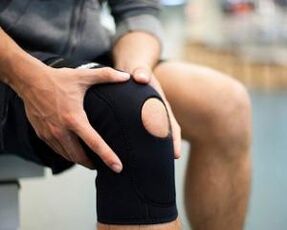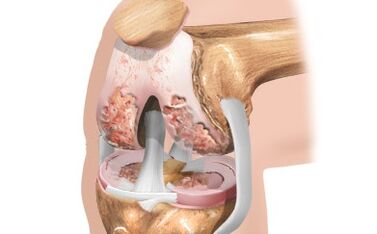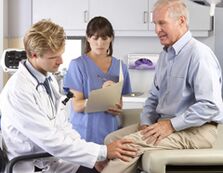Deformation of arthrosis of the knee joint is a polyetiological disease. This means that there are many reasons for its development. In some cases, when the most dominant cause can be distributed, gonarthrosis is called secondary. In the event that when a clear cause is not determined, the diagnosis of primary or idiopathic arthrosis of the knee joint is established.

- Deformation of osteoarthrosis of the medial part of the femur joint;
- Deformation of osteoarthrosis of the lateral part of the femur joint of the femur;
- Deformation of femur arthrosis.
Usually the destruction of the joint cartilage occurs in the process of physiological wilting of the whole body, that is, during aging. The pathological destruction of cartilage is considered when it occurs a long time ago or more intensive pace. The average age at which, on a completely legal basis, the first signs of cartilage degeneration may occur is a period of 40 to 50 years. With the deformation of arthrosis, the disease debuted in childhood with the first manifestations of 16 - 18 years, and in some cases even early. However, this is not a reason to despair.
The mechanism of the development of the disease is a vicious circle in which the end connections start the original and so on to infinity. However, each circle of this circle exacerbates the condition of the cartilage and leads to the progression of the disease and so on the chain. In the case of primary gonarthrosis, the cause that releases a vicious circle is unknown. Nevertheless, its subsequent relationships are carefully studied in order to influence them and slow down the progression of the disease.
Deformation of arthrosis develops approximately as follows. The daily articular cartilage of the knee joints experiences thousands of shocks that they are forced to be depreciated so as not to harm the more gentle structures of the human body, such as internal organs and brains. Over time, due to the data of the concussion, microscopic cracks are formed in the cloud layer, which are also filled with synovial fluid after a certain period of time and are converted to microdists. Neighboring microdists tend to unite and form more cysts.
The increase in the size of the cysts of the corneal space gradually begins to squeeze blood capillaries that feed the cartilage tissue on the side of the bone. The supply of IT with oxygen and substances required to maintain vital activity is impaired, leading to more slow collagen synthesis.
Cartilage carriage leads to two negative consequences. First, this leads to a deterioration of the depreciation properties and the more intensive formation of new micro -cracks in the daughter. Second, due to the cartilage compression, its density increases, which adversely affects the second mechanism of its diet by diffusing the synovial fluid in the thickness of the cartilage tissue.
However, in the scale of the whole body, the destruction of the articular cartilage does not go unnoticed. As a compensatory reaction to the focus of cartilage washing, the activity of chondrolists - young cells that synthesize new cartilage tissue - increases. However, this compensatory mechanism is imperfect and its imperfection lies in the fact that the greater part of the cartilage tissue is formed not in the place of the largest destruction of the cartilage, but where the cartilage does not experience loads.

As a result, the conical growths of cartilage at the edges of the joints are formed - chondrophytes. These chondrophytes do not occur clinically until the processes of ossification in them begin. Okreen, Chondroofytes harden and become converted, which are called spikes in ordinary people. As a rule, the onset of spikes is always accompanied by the onset of pain and the development of inflammation in the joint. This is due to the fact that osteophytes during the movement of the joint touch the cartilage tissue and the synovial sheath, thus damaging it mechanically.
As a result, any complication of deforming arthrosis leads to the acceleration of the progression of pathological changes in cartilage. However, knowing the mechanism of gonarthrosis development, one can successfully influence some of his relationships to slow down his current current one and improve the long -term forecast.
Secondary gonarthrosis differs from the main one in that the main cause that began a vicious circle of destruction of the joint cartilage is known. The more current course of the disease arises in the same way as in primary gonarthrosis, with the peculiarity that the disease is constantly worsening from the effect of the negative factors associated with the underlying disease. For this reason, the course of secondary arthrosis of the knee joint is generally more aggressive.
- Injuries (acute and chronic);
- congenital varus or valgus deformation of the lower limbs;
- congenital shortening of one of the lower limbs;
- Knee hypermobility syndrome;
- congenital knee joint dysplasia;
- chondrocalcinosis;
- osteomyelitis;
- rheumatoid arthritis;
- Acromegaly;
- Diabetes sugar;
- obesity;
- hypothyroidism;
- Fraud, etc.
After the traumatic deformation of arthrosis is divided into acute and chronic. The acute form of the disease develops after a serious injury, more often -

, which appears or partially extends to the joint part of the bone. The chronic form of the disease develops in a long time and is associated with frequent and mild joint injury as a rule. Such conditions are created by builders, road workers, wallets and more.
In acute gonarthrosis, the mechanism of the disease is associated with severe inflammatory changes in the joint cavity, namely lymphostasis, increased pressure in the joint cavity and a change in the composition of the synovial fluid. Excessive acceleration of the growth of new cartilage tissue leads to deformation of the joint surface at the site of fracture and the growth of osteophytes.
In chronic gonarthrosis, there is no severe inflammatory process, but frequent and intense loading on cartilage tissue leads to its rapid compression, the formation of micro -cracks and the worsening of cartilage supply with nutrients both on the side of the bone and on the joint.
People with this pathology can be found quite often. Its essence is to change the shape of the legs. With variant deformity, the legs bend out into a horizontal plane. In other words, there is more space between the patient's legs than in healthy people. In deformation of the valgus, the feet have an X-shape when the knees are in contact with each other. Both pathologies can be both genetically programmed and develop throughout life due to fractures of the lower limbs.
In both cases, the load from one of the sides of the knee joint increases, with deformation of the varus - from the sides and with deformation of valgus - from the medial countries. Due to the fact that the same weight of the patient presses on a smaller area, premature cartilage washing occurs, accompanied by inflammation, pain and morning stiffness.
The congenital shortening of one of the legs is a consequence of anomalies or may develop several years after birth as a consequence of birth injury. As in the previous case, an uneven weight distribution occurs and the normal leg acquires a large load. As a result, the joint cartilage of the knee joint on a healthy leg underwent structural changes that lead to the deformation of arthrosis.
This pathological condition is not a disease, but it can lead to it. This syndrome means excessive mobility of the ligament and consistent apparatus in which the movement of joints of the joints in normal axes can increase significantly. Such patients almost never suspect that they have such a trait because they live with it throughout their lives and believe that other people also function in the same way.

A sign of knee hypersimators is the formation of a stupid angle between the front surfaces of the thigh and the lower legs with maximum straightening of the legs. In other words, the knees bend as they were, and the legs take on a fervent shape. Also, such patients can easily reach the forearm with their thumb, reach their heads to the feet, and generally have congenital flexibility.
Symptoms of knee arthrosis joint
At the initial stage of development, the pathology is manifested by knee pain, moderately pronounced and arising as it moves as you move in the steps.
An unpleasant symptom may occur if a person spends a lot of time straightening or trying to rise after being in a sitting position for a long time.
At rest, health usually improves.
Acute intense severe pain occurs spontaneously.
Most patients had previously had prolonged discomfort during physical activity and walking. In this case, increasing pain may be the main sign of the development of gonarthrosis.
The disease develops gradually, for several months or years, when deformity and severe pain are not yet visible. But during this period, knee discomfort, which occurs from time to time.
Remember that the earlier you consult a doctor, the easier and easier to undergo treatment.
Do not delay a visit to a specialist in anticipation of irreversible consequences. Take action as soon as you notice the symptoms of the disease.
The obvious signs of knee arthrosis begin to manifest themselves as the structure of cartilage shells, a decrease in the production of synovial fluid and damage to the joint sac. In the initial stage of increasing pathological changes, there are as a rule no symptoms pronounced, but at the same time there may be mild stiffness in the morning.
When different symptoms are pronounced and appears, arthrosis is generally already in the late stage of their development. At that time, there was already serious damage to the structures of the knee joint, so the disease passed into the acute phase. The characteristic manifestations of the acute period of development of arthrosis include:
- increased pain;
- Change of gait;
- lame;
- crunching on movement;
- soft tissue swelling;
- increase in the knee due to the accumulation of fluid in it;
- Restricting mobility in the joint.

When knee arthrosis develops, the symptoms can grow long enough, but when the disease goes to the last 3 stage of manifestation of a joint disorder, the quality of life significantly reduces the quality of life.
- The synovial sheath against the background of damage to the joint surfaces begins to ignite, leading to a violation of the mobility of the whole joint.
- Any movement with a damaged joint can be very painful.
- Palpation has a significant increase in local body temperature.
- As a rule, the effective treatment of knee arthrosis with conservative methods is only possible in the early stage of the development of the disease.
- Thus, when signs of the disease occur, consult a doctor for consultation.
In the development of such a condition as knee arthrosis, symptoms and treatment are interconnected, because in the early stages of the development of the disease the joint surfaces can still be fully restored and improved by local metabolism, then in the short stages the treatment of the drug of the knee joint can not have a positive effect. They have a positive effect, as the marshmallows of the knee structure cannot have a positive effect, since in the short stages the treatment of the drug of knee arthrosis joint often cannot have a positive effect, since the masters of the capricious data are so exposed to the knee structure.
First degree arthrosis occurs almost without visible symptoms. This phase of development is characterized by:
- Leg fatigue;
- A slight reduction in mobility, which is usually observed immediately after sleep.
Symptoms of pain, if they occur, manifest themselves to a small extent. At this point, knee arthrosis looks in the X -rhina in the form of small irregularities in the cartilage tissue and the surface of the bones.
With arthrosis of the knee joint of the second degree, the symptoms are more pronounced. The pain already arises from the minimum load or immediately after it. In the affected part of the leg, the pain is caused by almost any movement. After a very long break, it usually goes completely. However, the next physical actions immediately cause pain.
At the approximately the second stage of the development of the disease, the sensations of pain are added:
- crunching in the knee joint during movements;
- Reduced possibility of leg enchantment normally in the knee;
- change of joints of the joints;
- Progressive synovitis.
Grunt arthrosis of the joints, as a rule, is first barely sound, but with the course of the disease it becomes very strong and different. When you try to bend your legs in the knee, there is acute pain. In some cases, this is only up to a 90 degree angle, and then with difficulty and overcoming pain. The change in the shape of the joint is also obvious, which also deteriorates by the accumulation of pathological fluid in it.

The characteristic characteristics of the 3rd degree of arthrosis are severe pain that is independent of the amount, the intensity of physical activity. The joint becomes the labor of a person even at night, it causes significant inconvenience.
Radiography can show global changes in cartilage, joint surface, uncharacteristic outgrowths. The O-shaped or X-shaped curvature leads a person to disability. These are the consequences that cartilage tissue is already worn and bone tissue enters the "movement".
Gonarthrosis is a disease with a degenerative dystrophic nature, with the destruction of cartilage and the joint deforms. The signs of the disease are severe pain, deformity of the limbs, uneven distribution of bone system load, the development of complications and a significant reduction in mobility to damage the patient.



















